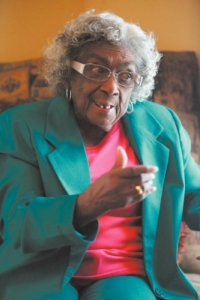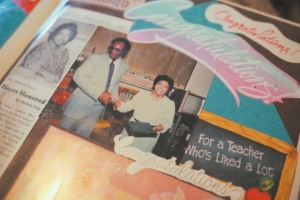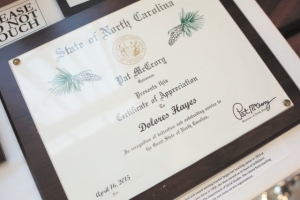Part of history
By Becky Barclay
Published in News on March 5, 2018 11:34 AM

News-Argus/CASEY MOZINGO
Dolores Hayes has not only seen history, but she's been a part of it.

News-Argus/CASEY MOZINGO
Dolores Hayes was honored as Wayne County's Teacher of the Year in 1983. She has received several other awards from various groups over the years.

News-Argus/CASEY MOZINGO
Dolores Hayes' Order of the Longleaf Pine Award from Gov. Pat McCrory in 2013 is on display at the Wayne County Museum.
Dolores Shaw Hayes was a bit apprehensive when she was chosen as one of the first three black teachers to start the integration process at an all-white school, but she told her principal she would go where he sent her -- and she did.
That was the 1967/68 school year, and Goldsboro's high schools had not been integrated yet.
"I didn't want to go," the 83-year-old Hayes said. "I was at Dillard High School, which had the recognition of being the premiere school around the state."
Hayes and two black male teachers were sent to Goldsboro High School while three white teachers from that school were sent to Dillard High School. Hayes went as a social studies teacher and chairman of the department.
She became part of history.
But it's not the only thing that has enriched Hayes' life.
She was born in Burgaw in 1934.
"There were only one or two white doctors there, and of course, they had their waiting room segregated, one for whites and one for coloreds," Hayes said. "That was back in the 1930s and 40s as I grew up. That was the way of life back then. You sort of took it for granted."
Hayes lived the small town life as she grew up in Burgaw.
"There were no fast food places and only one restaurant," she said. "After Mama got up in years, she decided she had cooked enough in life. So she and my aunt would go out to dinner every day. They'd bring something back for my Daddy and for the cat."
Hayes attended college at A&T University.
"In those year, for black women, you either were a teacher or a nurse," she said. "It was that way for white women, too, but moreso for black women. We also went to historically black colleges and universities."
Hayes taught at E.E. Smith High School in Kenansville where she met her future husband, Dr. Lonnie Hayes. Her future sister-in-law was also teaching there, and when she got married, she asked Hayes to be her bridesmaid. Dr. Hayes was a groomsman.
"We met and hit it off," Hayes said. "He was still in medical school.
"He always wanted to be a doctor, but when he graduated from high school in Windsor, there were no schools in North Carolina he could go to," Hayes said. "He went to school in Ohio for his Bachelor of Science degree, then to Howard University in Washington, D.C., to get his medical degree."
When Dr. Hayes returned to school in D.C., Hayes decided she wanted to get her master's degree -- at a school in D.C.
"He would tell everybody that I followed him up there," she said. "And I said, 'I sure did.'"
In college, Hayes was a biology/chemistry major.
She went to work at the National Institutes of Health, a big experimental hospital in the D.C. area.
"Usually when patients came there, it was their last resort," she said. "The doctor I worked for was anxious to find out why cancer patients lose so much weight. One Monday I came to the lab and there was a note from the doctor for me to dissect one of the patient's liver, a man I grew to love who reminded me of my granddaddy.
"That's when I was still single and my husband-to-be asked me what was wrong. I told him I couldn't stand it."
The two dated and were married in 1961.
After Dr. Hayes finished his internship, the couple moved to Goldsboro, where Dr. Hayes became the first black surgeon at Wayne Memorial Hospital and Hayes got a job teaching history at Dillard High School. She had taken a lot of extra classes in social studies in college.
ÃÆ'¢â‚¬Â¢
Hayes recalls her teaching days at Goldsboro High School when local schools were being integrated.
"The students came to me not just for class, but they also came to my classroom to do homework while waiting for the bus to finish dropping off the elementary students," she said.
She also remembers the day the black students walked out -- at the time Martin Luther King Jr. was assassinated.
She said at the time, the high school had co-student council presidents, one black and one white student, co-homecoming queens, co-cheerleaders, co-everything -- one black and one white student.
She said the black girl who was co-student council president left school and was not replaced, leaving only the white student council president. She said the black students were upset by that.
"We were in the stadium and the black students got up and walked out," Hayes said. "The kids were out just milling around the gym parking lot.
"I sat there saying to myself, 'Lord, don't let those children get out there and start throwing bricks and having a riot. Washington, D.C., had been on the news and it looked like it was in flames."
The principal called Hayes to the intercom, hoping she could convince the students to return to their classes, which she did.
Hayes was a popular teacher at Goldsboro High School -- and a very compassionate one, too.
The students often came to her with their problems.
Although they had one child of their own, Carol, Hayes and her husband took in some of the children at the school.
Anetta Reid was one of those, and she still lives with Hayes today, helping care for her as she is on dialysis.
"One girl I got in seventh grade and kept her through high school," Hayes said. "Her mom had 11 children. She went on to college."
Dr. Hayes' nephew also came to live with the couple. His parents were divorced and he was about 12 when his mother decided he needed a male role model and asked the Hayeses to take him in. They kept him through 12th grade and helped him get off to college.
Hayes retired from teaching in 1995 and her husband died in 2006.
Looking back at her part in the integration process, Hayes said, "Integration went smoothly. It wasn't long before everything just melted in."
